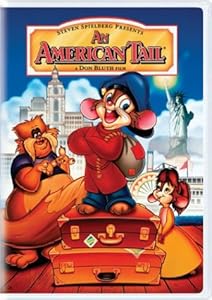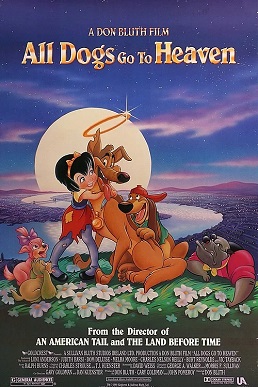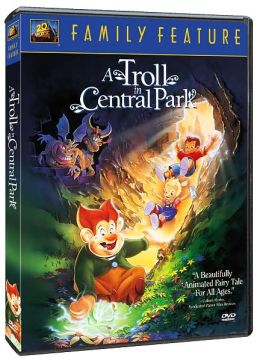Don Bluth
 |
| The man. The myth. The mustache. |
Here is a quick history on Don Bluth. He grew up loving Disney's original movies and he eventually got a job to do plenty of animation work for Disney. However, as the quality of the movies and the animation began to drop during the 1970s, Don and some of his Disney buddies decided to leave in order to make animated movies of their own. They wanted to make animated classics that were at the same quality as the early great works of Disney.
The 80s Success
Don Bluth managed to fulfill his dream of creating quality animated classics. His company's first feature length movie The Secret of N.I.M.H may not have been a huge hit at first, but it has gained popularity over the years on home video and it was enough to attract the attention of Steven Spielberg.
Spielberg, and eventually George Lucas, helped in producing the next high quality movies by Don Bluth. These were An American Tail and The Land Before Time.
These first three films have kind of been childhood staples since their creation and I think it's because of not only the creativity of the stories, but the unique style of art that Don Bluth brought to the movies. That is why these movies have carried on all these year. Even the next film, All Dogs Go to Heaven, has been a somewhat popular movie that may not be as great as these earlier works, but still remains known nonetheless.
Don and company can probably count themselves not only lucky that these movies were top-notch animated-classics-in-the-making, but that these movies also happened the come out while Disney was still in a bit of a slump of sloppy, non-classic works.
What Happened in the 90s?
Disney's slump quickly came to an end with a Renaissance period part in thanks to its return to the princess formula. Meanwhile Don Bluth tried to compete, but his method of competition left something to be desired.
| Apparently cutesy animals doesn't always mean box-office gold |
Some of these movies above may be unfamiliar to you, or perhaps they are faint memories of the one time you saw them as a kid and then quickly forgot it about the next day (save for maybe "Thumbelina"). I think that what happened here was an interference in the production by outside sources.
The, people who put money into a product want the result to please them, right? So, most likely, investors who helped finance the productions probably wanted specific things from the movie that they were funding (for more detail on this explanation, search Don Bluth Films on Facebook and look at responses to people's questions). In order to please the people who paid to create the movies, Bluth and team scrambled together several duds.
The Grand Finale
Don Bluth ended his directorial career with two very interesting movies. Anastasia and Titan A.E.. The former introduced a little bit of computer animation to non-Disney movies, since the world of American animated filmmaking began to rely on more on computer generated images, and Bluth's ability to adapt CGI into hand-drawn animation was presented in Titan A.E.. As I said in the previous post, part of the popularity of Anastasia was that it stuck to the princess formula while Titan A.E. has kind of remained in obscurity. I actually kind of like Titan A.E. because of the creativity of the story as well as the artwork that came from that movie. However, even these two movies were not enough to keep Don Bluth in competition with Disney and so he went off to work on other projects.
Legacy
I think the fact that I recently had a random conversation about whether An American Tail or its sequel An American Tail: Fievel Goes West shows that Bluth, along with his animation team, has created and established movies that last. I think that a lot of people in my generation can say that they had a Don Bluth movie or two on their movie shelves next to the Disney movies, which shows that Bluth was at least doing something to attract attention.
Why was Bluth and his animation team able to compete against Disney for as long as they did? Well, they were doing things right, at least during the first few films. They made films that contained high artistic quality. Even though majority of the characters in these movies are animals, the characters moved and acted with humanistic qualities which did not detract from the films but instead gave them more depth. The animators were also not afraid of utilizing unique animation styles such as rotoscoping. Not to mention the fact that Bluth gave his movies a large scope. When we see Fievel the mouse looking at New York City from atop the Statue of Liberty or dinosaurs fighting or a space ship flying through the galaxy, we see characters in larger than life situations against grand backdrops.
I think the greatest thing that set out Bluth and his company was Disney was that the maturity of his movies was greater than majority of Disney's. These movies were darker than most Disney features and often had creepy moments, yet these films were still appropriate for kids. These are movies that treat their audience with maturity and respect, instead of thinning the plot or characters. Adults can sit through this movie without cringing from any cheesiness or silliness that comes from other cartoon features. Kids watch this movie knowing that they are risking being scared at certain scenes, but understanding that the risk is worth it because of how good the story is
In the next installment, I will examine the other company that has competed against Disney, which will bring us in to the present moment in animated movies. There's still plenty of good things to come in this series.









No comments:
Post a Comment